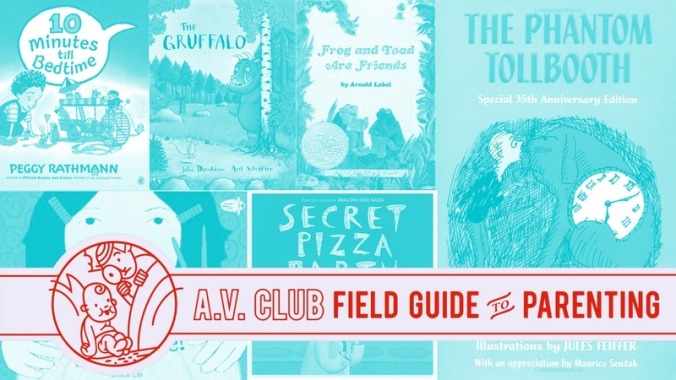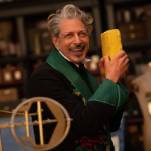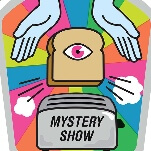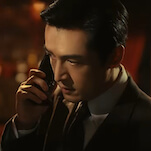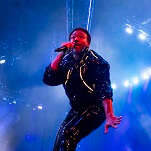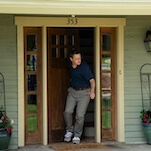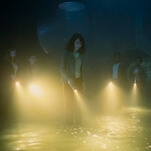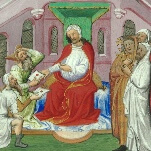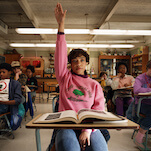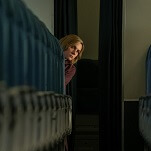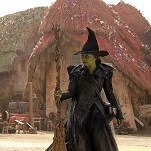You can wander into the children’s section at any library or bookstore and easily become completely overwhelmed by the seemingly limitless number of books available for your offspring. Before they’re old enough to pick out titles themselves, how are you able to select out the best, most engaging ones for your children? Our A.V. Club panel of parents is here to help, with some tried and true classics from our own kids’ bookshelves. We’ve got chapter books, picture books, board books, even books with scarcely any words at all. Hand off some of our selections to your own kids, and you may even be able to snag a few free moments to get some summer reading in yourself.
When my son was very young, we loved to read to him—and he loved to hear—the gorgeously simple I Am A Bunny, written (all 50-some words of it?) by Ole Risom and illustrated by Richard Scarry, though not in the busy-ass Busytown style that would become his trademark. Bunny is a tall, skinny board book with delightfully detailed portraits of Nicholas (he is a bunny) enjoying the various seasons. It’s incredibly calming for both parent and child, with its simple declarative sentences (“I am a bunny. My name is Nicholas. I live in a hollow tree.”) and lovely little nature scenes. I happened to be talking about it the other day with my son, who’s now 7 and well past the target age for I Am A Bunny, and I was delighted that he actually still remembered some of the lines from the story.
As my son’s gotten older, he’s been more interested in things that aren’t calming at all, and Secret Pizza Party fits the bill nicely there. It’s about a raccoon who’s always lusting after pizza, but who’s mercilessly chased away from the restaurant by a man with a broom. It diverges into the absurd (pizza hanging on the wall of a museum, pizza served in a bathtub) before getting totally nuts, as the raccoon hatches a plan to dress up as a person and basically steal a pizza. It ends with our hero rolling around orgiastically in a pile of pizza slices, then running off with all of them bundled in his paws. Victory? Or a blatant endorsement of thievery and greed? It probably doesn’t matter.
My 17-month-old son is half Chinese. But even if he were 1/32, any trace of Chinese blood requires his parents to acknowledge his culture’s deep obsession with food. (We Cantonese use a common greeting in our vernacular: “Have you eaten yet?”) So why not start our indoctrination young?
The Maurice Sendak Nutshell Library offers cautionary tales for toddlers
Yes, Where The Wild Things Are is a masterpiece, and I understand why it’s what Maurice Sendak is known for. But growing up I continually read two short stories of his: “Chicken Soup With Rice” and “Pierre.” The first is about a young lad’s infatuation with the salty, yummy taste of chicken soup with rice. So much so that he explains how each month of the year he’ll enjoy it a different way. The latter book takes a look at a young boy, Pierre, who’s the epitome of the terrible twos. Pierre can’t stop repeating, “I don’t care,” and ends up (spoiler) in the belly of a lion.
I couldn’t wait to read these two books to my 2-year-old son, Henry, and was pleasantly surprised to learn they both exist in a collection of Sendak shorts called
Nutshell Library. The stories are very Sendak in that the characters are mostly wild boys (very relatable for my son), but they provide a little bit of learning as well. Learn the months while reading about soup, learn the alphabet while reading about obnoxious alligators, learn your numbers while reading about a gang of uninvited guests, and learn to care or else get eaten by a lion. The books also come in a ridiculously cute size that’s perfect for tiny hands. At this point Henry wants to “read” them to me—which is just him sitting on my lap, holding the book, and recalling one or two words based on the pictures on the page.
If you want to add an extra level of fun to story time, Carole King and Maurice Sendak worked together on a 1975 animated TV special called Really Rosie that took all four of these short stories and put them to music. You can listen to the soundtrack today, but be warned that you’ll be humming about chicken soup with rice for hours afterward.
[Eric Munn]
The beyond-valuable aspects of The Phantom Tollbooth
One Sunday when I was about 8 years old, a kindly retired schoolteacher who attended our church unexpectedly handed me a brand-new paperback copy of Norton Juster’s 1961 children’s novel The Phantom Tollbooth. She told me it was her favorite book and that it was written just for a kid like me—bright but shy. That afternoon I started reading. And like the story’s hero, Milo, who is spontaneously gifted with a passageway to another dimension, I quickly got caught up in the adventures of the “Kingdom Of Wisdom.” I became fascinated by the cities of Dictionopolis and Digitopolis, which have been warring ever since the brothers who rule those lands—King Azaz and The Mathemagician—banished their more level-headed sisters, Princess Rhyme and Princess Reason.
Later, when we had kids, my wife and I would read to them nearly every night for pretty much the first five or six years of their lives (even after they’d learned to read on their own). Toward the end of the respective bedtime story years, I broke out The Phantom Tollbooth. My math-obsessed son and my artsy daughter had very different reactions to different parts of the book, with each enchanted in their own way by the idea of a kingdom where letters and numbers—and the respective concepts they can be used to conjure into existence—have become physical entities, to guide or confound Milo.
But it took them a few years—when they could read The Phantom Tollbooth to themselves—for them to see that there’s more to Milo’s story than just him learning to navigate the vast realms of knowledge. The novel is also about being lonely and restless, and feeling like your peers have figured out something about how to get along in the world that you’ve never been able to grasp. For my smart kids—both misfits in their own way, like I was at their age—that strong sense of helpless melancholy was as essential to “getting” The Phantom Tollbooth as Juster’s funny episodic plot or Jules Feiffer’s cartoony illustrations. The book itself is a portal to understanding and accepting how life is, designed to be given to children who need it. It worked for me in the ’70s, and it worked for them in the ’00s. It’s a sturdy little device.
[Noel Murray]
The very best board books
When my twins were babies, I spent most of the time they were awake reading picture books to them while they were strapped in their bouncy seats. Since they had no say in the matter, I would rattle off six to eight at a time, until I knew most of our favorites by heart. Even at that age, it was clear that my son preferred the works of Eric Carle, while my daughter liked Sandra Boynton. When they started crawling, board books became a necessity, because regular books in their grubby little paws would just get destroyed. Board books would, too, but at least it took a little longer.
My all-time favorite book from this now-departed era is The Gruffalo. It’s a pretty simple parable about a small woodland creature defeating a series of predators with a clever mind trick. But the rhyme scheme by Julia Donaldson, a former songwriter, is absolutely melodic and was extremely enjoyable to read aloud, as was coming up with different voices for the mouse, the fox, the owl, and the Gruffalo himself. The book was so popular, featuring charming illustration by Axel Scheffler, that it spawned several sequels, as well as the pair’s similarly engaging Room On The Broom, a must around Halloween. (I passed on my copy of this book to editor Sean O’Neal, who declared it a hit with his kids as well.)
For board books with few to no words, we favored Peggy Rathmann’s Good Night, Gorilla and 10 Minutes Till Bedtime. The former is so common it might be an automatic get at most baby showers, but we probably preferred the latter. Not only does it offer a lesson in counting backward (and a refrain you can use often to rally your own bedtime troops), but it’s also fascinating for young kids to look at, as the activities of the giant family of hamsters preparing for bed seems to become more elaborate with each page (turning the bathtub into a community pool, for example).
Similar to Noel’s family, my now grade-school-age kids still let me read to them at bedtime (currently in rotation: Rick Riordan’s Magnus Chase And The Gods Of Asgard: The Hammer Of Thor and Roald Dahl’s Danny The Champion Of The World). Although there’s no real reason for me to hang on to our old, beyond-battered copy of The Gruffalo, somehow I think it’ll stay on our bookshelf forever.
[Gwen Ihnat]
Frog And Toad are a kid’s best friends
Speaking of books inherited from Gwen, passed from her twins to mine, my girls have also developed a quick affinity for Arnold Lobel’s Frog And Toad
series—something I found immensely gratifying, because they also ranked among my favorites when I was a kid. Revisiting them now (as I do, by request, almost every night), I can see what I loved about them: They’re actually pretty funny, albeit in a low-key, Reader’s Digest sort of way that rewards little minds for recognizing that there’s even a joke to be had.
Across the four story collections (Frog And Toad Are Friends, Frog And Toad Together, Frog And Toad All Year, and Days With Frog And Toad), the pair gets into some comically mild misadventures, often revolving around Toad being slightly stubborn or uptight: He doesn’t want anyone to see him in his silly bathing suit; he’s too impatient for his garden to grow, so he starts shouting at the seeds; he loses his to-do list to the wind, then refuses to chase it because it’s not on his list, and so on. Meanwhile, Frog acts so patient, caring, and immutably loving toward Toad, even at his most irritating, some have suggested that they’re more than just friends. Notably, Lobel’s daughter, Adrianne, told The New Yorker last year that her father came out to his family shortly after the first book was published, and that she now believes that Frog And Toad was his way of exploring the same-sex intimacy he’d long repressed.
You don’t have to agree with that interpretation—many don’t—to enjoy Frog And Toad, which is foremost a story about the joys of friendship, whose virtues I keep trying to impart to these two tiny, squabbling girls who have to share a bedroom, are constantly grabbing things out of each others’ hands, and seem to love making each other cry. Right now they’re not especially receptive to the message; mostly they’re just into pointing out to me that Frog And Toad contains pictures of frogs and toads, and that sometimes they wear shoes and jackets. Still, I look forward to the day when they finally start to appreciate its gently deadpan humor, and all three of us can be friends sharing a dry little chuckle together.
[Sean O’Neal]
